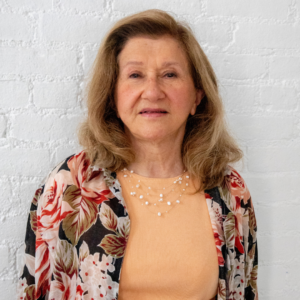- What was it like when you walked into that room at NYU, more than 40 years ago, with your diagnosis fresh in your mind, and SHARE in its earliest days?
I was very young at that time and didn’t know anyone my age who had gone through this. My mother died of breast cancer, and my father died of bladder cancer seven months before I was diagnosed.
I was fortunate to have Dr. Eugene Thiessen as my surgeon. He was the one that brought women with breast cancer together in the support group that became SHARE. I remember going into my first meeting and thinking, “will it be months… years… will I even make it to 40?”
I went into the room and there were a bunch of vital, lively women moving furniture around. At that moment (after surgery), I could barely move my arm. I thought, “These women could not have all had breast cancer.” That first impression gave me courage, knowing you can go on and have a life after breast cancer.
I remember knowing that I was not going to do this the way my mother did. She was an immigrant, not comfortable with English. And not only did she have cancer, but she was ashamed about it. There was a stigma. So I just told anybody who wanted to hear — and some who didn’t want to hear — that I had breast cancer.
2. You have played multiple roles in your work with SHARE — group facilitator, board member, and program innovator, to name only a few. What inspired you to play such an important part in writing SHARE’s story?
Part of it was how it helped me. The other part was what I could do for others—that was what brought me back to life again.
Lee Miller (one of the original 12 women Dr. Thiessen brought together in 1976 and a prominent SHARE leader for 37 years) was my mentor for many years, and I miss her terribly. She took me under her wing and trained me to be a facilitator. Over the years, I facilitated just about every type of group SHARE offered: newly diagnosed, young women, friends and family, ongoing and more. I was also a board member for many years and served as vice president.
It was especially important to me that we reach underserved communities — women like my mother and others in similar situations. Alexandra Colon and I (we were both board members at the time) decided to try and work with people who had no access to the support and information they needed. They needed to know that others were going through what they were; they needed someone to give them hope for a future.
3. How has SHARE changed through the years? How has it stayed the same?
When I was first doing support groups, we had no place to meet. I remember one meeting at a gym in my neighborhood where we could hear a basketball being thrown against the wall in the next room! There were no funds, so we would chip in a few dollars here and there for phone calls.
There have been so many phenomenal women who joined and got involved. Our original bookkeeper and secretary in charge of everything — in the beginning, all of our records were under her bed — that was our office.
One of the ways we reached women was by talking to physicians who did not know what to do with their breast cancer patients after treatment. We didn’t even have brochures then, but the doctors were very responsive.
That same drive is still there. Today, SHARE is a national organization, with staff and an office, and we reach many more people.
4. Looking ahead, what opportunities do you see for SHARE?
We need to continue to work to reach more people, especially in underserved communities. I know how important ZOOM meetings have been during the pandemic, and they do make SHARE accessible for many more participants. The doctor-patient relationship is an important area where we can help; patient navigators have an important role to play.
Of course, my biggest hope is for the time to come when we don’t need SHARE because we have a cure for breast cancer.
Thank you to Nancy Roylance for your help in writing this article.
